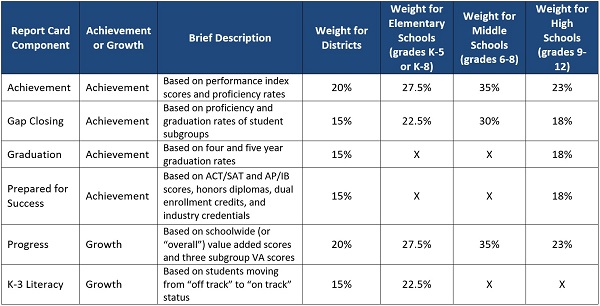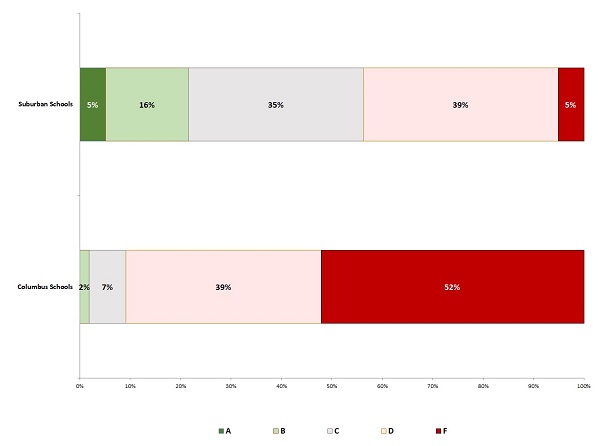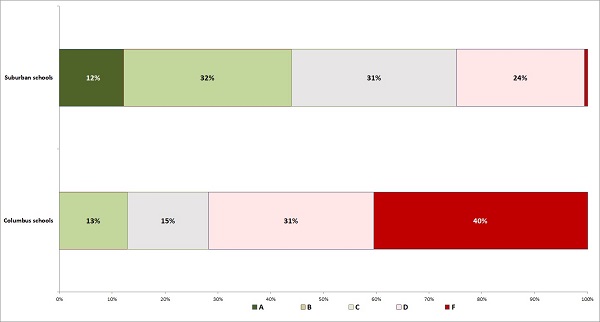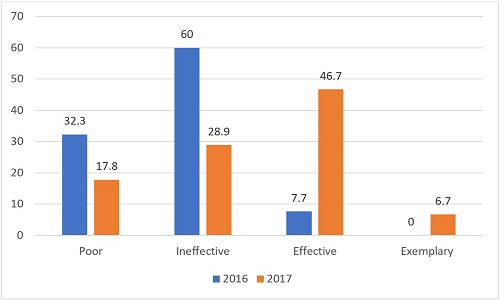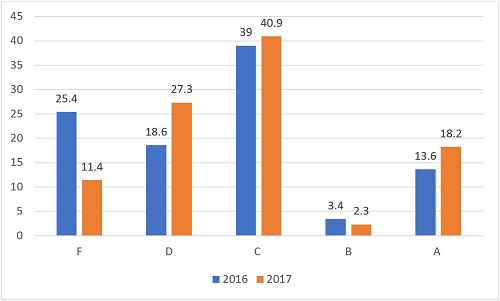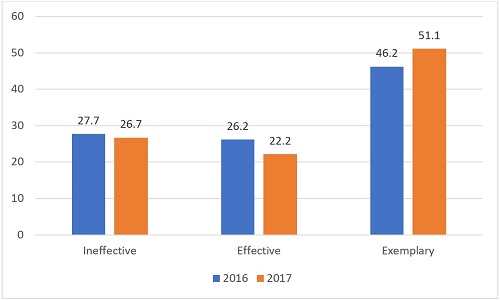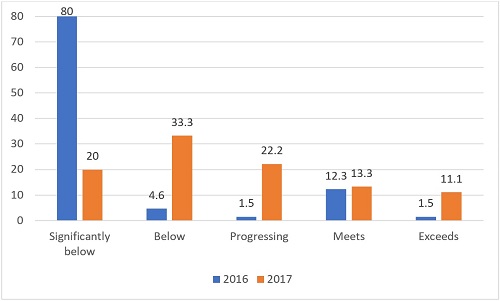Since 2012, the Center for Education Reform (CER) has released an annual “parent power index,”—a scorecard for states as well as an interactive tool for parents “to discover whether their state affords them power over their child’s education—and if not, what they can do to get it.”
The index rates states along five categories: (private) school choice, charter schools, online learning, teacher quality, and transparency—and then provides an overall score. It also offers quick facts on statewide achievement (NAEP proficiency and ACT scores) and student enrollment. On the latest index, Ohio ranks eleventh in the nation and scores well above the national average in all but one of the five categories.
How Ohio performed on the 2017 Parent Power Index
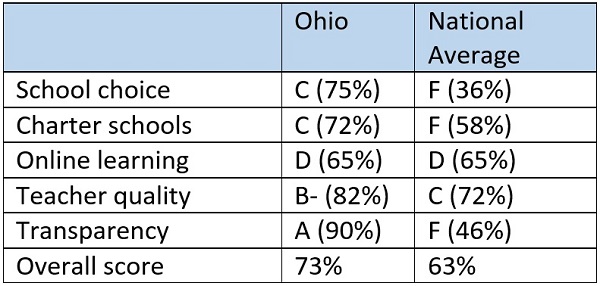
The question CER seeks to answer is an incredibly important one: how much power do parents really have? Unfortunately, this particular index is only partially accurate. Let’s take a quick look at what it got right, where it went askew, and how this local Ohioan views parent power in the Buckeye state.
School choice
The index gave Ohio a C for school choice, listing out its four statewide scholarship programs and one specific to Cleveland. Given the size, strength, and history of Ohio’s scholarship programs, Ohio should have scored higher.
For starters, Ohio has 60,000 EdChoice scholarships available for families whose zoned schools are categorized as academically failing. As of yet, that limit has not been reached. The state also expanded the program in 2013 to make families eligible for scholarships based on income—a better, fairer way to determine eligibility. The program has phased in during recent years, and today, lower income students in grades K to 4 are able to access private schools through a state-funded scholarship. Every resident of Cleveland also has access to private school choice through a city-specific voucher program, which is the second-oldest program in the country (next to Milwaukee’s). Finally, Ohio has two programs for students with disabilities—the Jon Peterson Scholarship program and one specific for children with autism.
CER seems to focus only on private school choice. It overlooks Ohio’s robust inter-district open enrollment program, regional STEM and career and technical schools, dual college and high school enrollment programs, and homeschooling options. (Public charter schools and online options are separate categories in CER’s rating system; see the sections below.) In the area of inter-district open enrollment alone, for instance, 488 of Ohio’s 614 school districts participate in the program, and over 70,000 students opt in, enabling them to access better choices, a wider array of courses or extracurriculars, and a host of other benefits.
However, even sticking with CER’s narrow focus on private school choice, Ohio deserves a B. (CER doesn’t indicate where Ohio got dinged in this category.) Expanding income-based scholarship slots (which are currently full), creating an educational savings account program that would enable parents to have greater flexibility in spending and to close opportunity gaps, and incentivizing more high-performing suburban districts to accept open enrollees would boost parent power even further.

Charter schools
CER hands Ohio a C (and a rank of 24th) for its charter schools. The index rightly criticizes Ohio’s funding disparities for charter schools—as it relates to both facilities and operations dollars—and is correct in worrying about a lack of “diversity and innovation” in the sector. It’s a concern I share.
But blaming this on Ohio’s highly regulated authorizer environment, as CER does, is incomplete, though true in some respects. Ohio’s quality problems over the past two decades are just as much at fault for thwarted innovation. And while I’d agree with CER that charter growth should be allowed beyond Ohio’s Big 8 urban districts and academically challenged areas, the index is glaring in its omission of any mention of quality. Yes, Ohio’s sector has shrunk a bit over the past few years; authorizers are more heavily regulated; and some caps are in place—though only the geographic cap is placing any functional limit on charter options.
But the goal—especially as it relates to empowering parents to have access to good choices—shouldn’t be simply to make the sector bigger and freer. Ohio already tried that. Uneven charter quality, blatant conflicts of interest, and a lack of accountability and transparency led to much of the overregulation currently impacting the sector today. According to CER, Ohio deserves a C grade because of too much regulation, caps on new schools, and funding inequity. It misses the boat in not even mentioning Ohio’s uneven quality.
Ohio could enhance parent power in the realm of charter schools through the following actions: tweaking its authorizer evaluation so as not to penalize authorizers for overseeing high-poverty schools (evaluations that are too stringent on proficiency rates could effectively create a moratorium on new schools); increasing facilities and operations funding for charters; making it easier to replicate excellent models or to recruit great national networks to the state; addressing virtual schools’ quality issues carefully and thoughtfully; and lifting geographic caps such that charters could start up elsewhere, not just within Ohio’s most distressed communities.

Online learning
Ohio earns its lowest score from CER in the area of online learning—but for reasons you may not expect. With well-documented quality issues and the state’s largest e-school at the forefront of state and national news coverage, it’s perhaps the single most-talked-about charter issue in the state, despite the fact that just two percent of Ohio public school students attend an e-school and the attendance tracking issues are far more nuanced than most would like to believe.
CER says that Ohio’s full-time online options are “limited in scope,” but it’s hard to understand how they could reach that conclusion given that Ohio has ten statewide full-time e-school options, and eight more local options. Ohio lifted the cap for new e-schools in 2013, and since then, three new virtual charters have opened. But if anything, scant enrollment at the newest virtual charters might indicate that Ohio’s virtual school market is over-saturated.
Again, any discussion of parent power should center on quality, not just access. The state has a long road ahead to determine how students can be best served in a virtual environment. The index is right, however, that blended options are limited. So are part-time virtual options such as an online course-access program.
Ohio deserves a D grade in this category. Parent power could be enhanced by overall quality improvements to the virtual school sector; exploring policies that better ensure that students who attend e-schools have sufficient supports to be successful in this type of learning environment; the creation of authentic blended classroom options; and offering access to advanced coursework on a virtual platform—so that e-learning no longer has to be a full-time option and could be done in partnership with existing districts and charters.

Teacher quality
CER doles out grades that mirror what’s given by the National Council on Teacher Quality in its state teacher policy yearbook—in this instance, a B minus for Ohio.
Teacher quality is no doubt the greatest influencer of student achievement within the four walls of a school, and as such is at the forefront of parents’ minds when making schooling decisions. However, no parent has real power to consistently choose her child’s teacher, so it’s odd to see this category in this index.
The closest we can get to true empowerment on this front would be the dual combination of allowing parents to choose their child’s school and then empowering school leaders to be able to hire the teachers they want (as is the case with charter and private schools).

Transparency
Ohio receives its only A grade in this category, but CER is light on details. With no sources to external ratings or how/why it gives this grade, it merely states, “School report cards are easy to access and present data in a very accessible manner.” This is far too generalized. While Ohio does have easy to understand A through F grades, its lengthy, highly technical report cards have much room for improvement—the topic of a forthcoming Fordham Ohio report. Moreover, ensuring that parents have readily usable information with which to make schooling decisions goes well beyond whether they can download state-level report cards.
I give Ohio a C grade—not only because Ohio’s current report cards are lengthy, wonky, and hard to understand, but because there are so few entities in our state devoted to helping parents understand publicly accessible information. School Choice Ohio helps parents with navigating the state’s voucher programs, and the Cleveland Transformation Alliance assists Cleveland parents. But nowhere in Ohio is there a city-wide common application/enrollment system. Some of the state’s best schools still have open seats, and parents of all stripes continue to struggle to make sense of not only report card data, but their own district enrollment processes, timelines, and options as well.

Overall, while CER should get credit for attempting to answer a vital question, their rating system needs a refresh. And Ohio itself could do a better job empowering parents. Stay tuned for my next post, a deeper dive on parent power.



